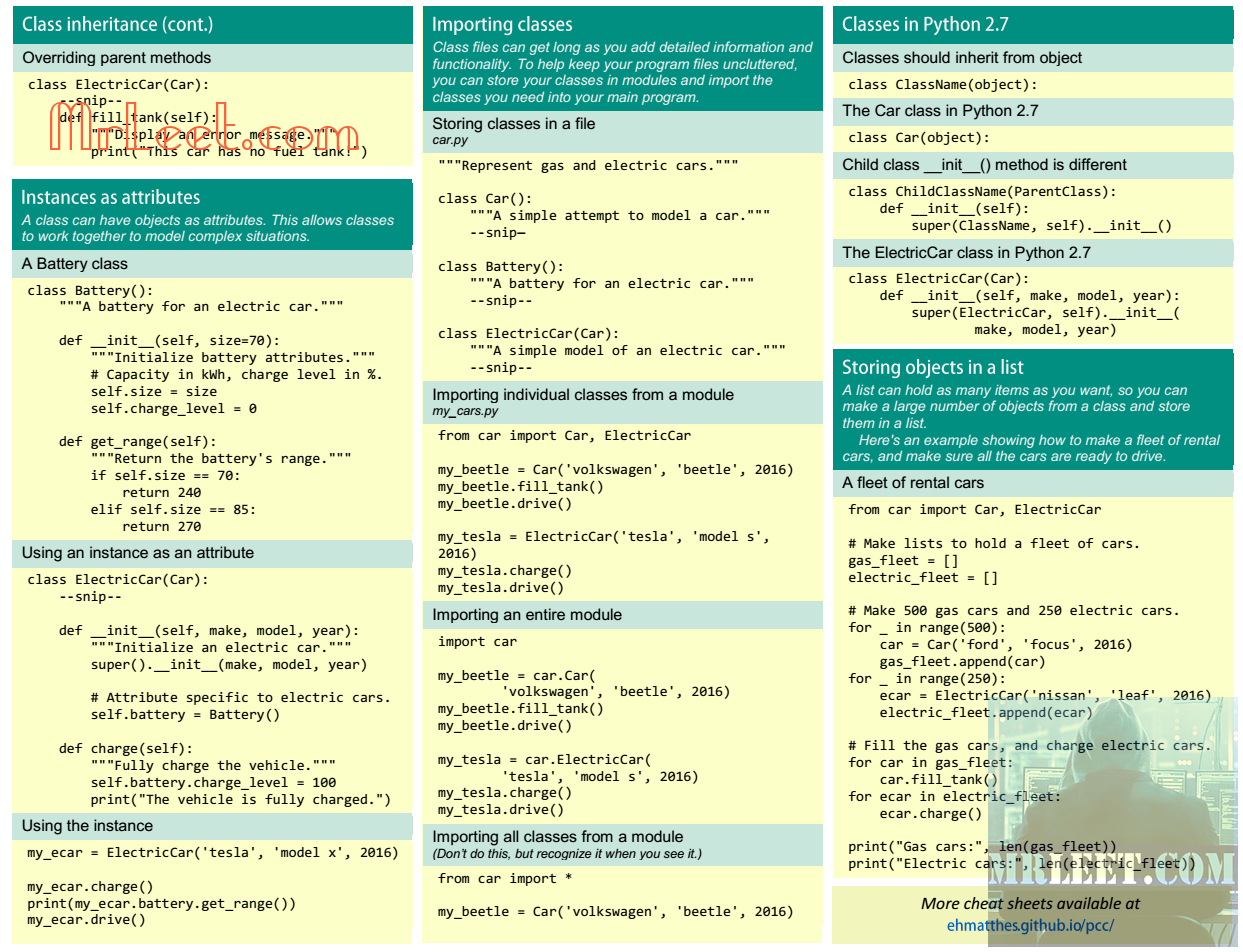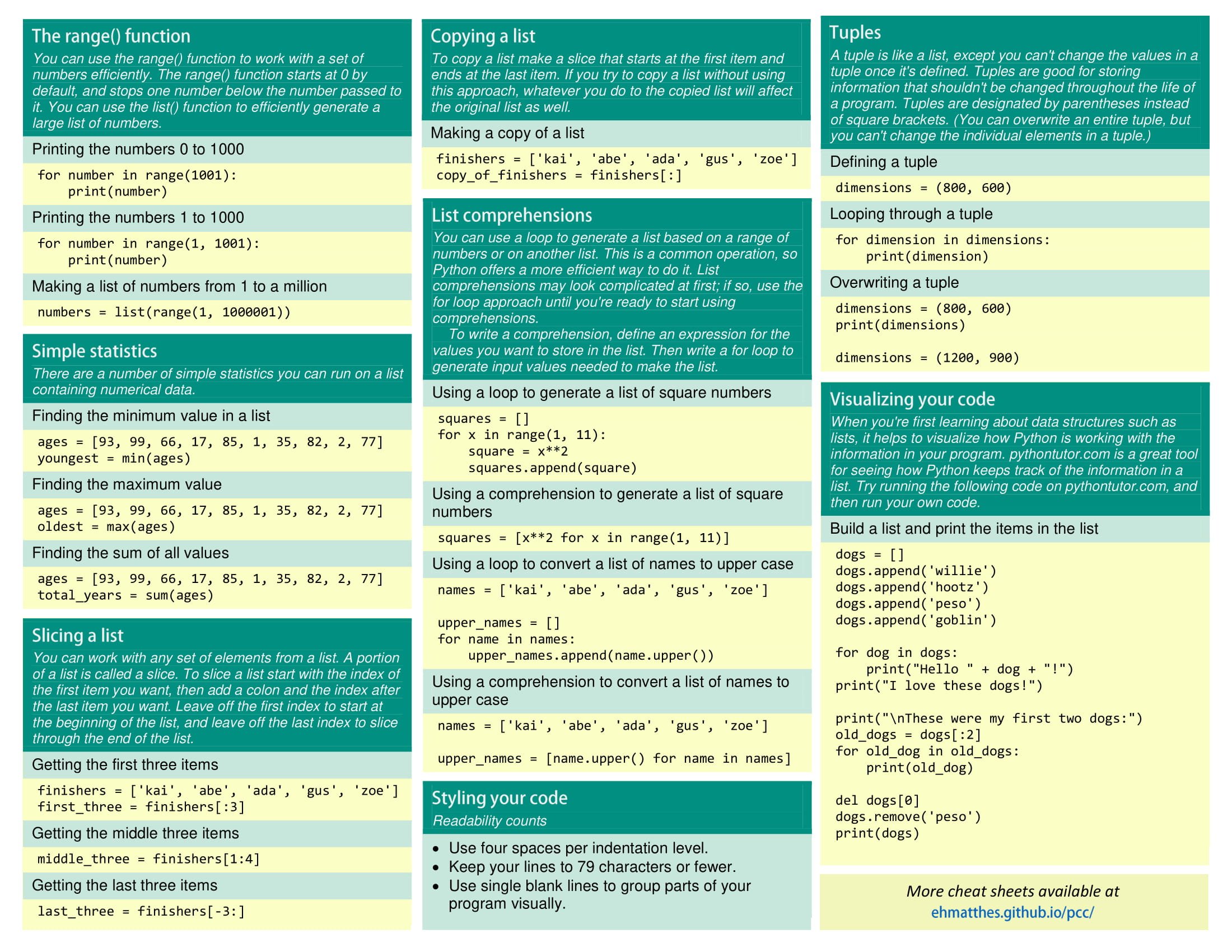- Python Cheat Sheet For Beginners
- Python Crash Course Cheat Sheet
- Beginners Python Cheat Sheet
- Basic Python Cheat Sheet
Beginner’s Python Cheat Sheet - Dictionaries Focuses on dictionaries: how to build and modify a dictionary, access the information in a dictionary, and loop through dictionaries in a variety of ways. Includes sections on nesting lists and dictionaries, using dictionary comprehensions, and more.
- This cheat sheet is the most concise Python cheat sheet in the world. It contains keywords, basic data structures, and complex data structures—all in a single 1-page PDF file. If you’re lazy, this cheat sheet is a must!
- Javabeginnerstutorial provides Tutorial for beginners to learn the basic concepts of Java and realated technologies. You will learn the fundamentals. Topics also contain cheatsheet for a quick review of what you have learned in a given topic.
- Python for Beginners –Cheat Sheet Data types and Collections i nt eger 10 fl o a t 3.14 b o o l ea n True/False s t ri ng ‘abcde’ l i s t 1, 2, 3, 4, 5.
- Python Cheat Sheet: Python is a multi-paradigm general-purpose, object-oriented programming languageIt is a cross-platform programming language.
- Python is a multi-paradigm general-purpose, object-oriented programming language
- It is a cross-platform programming language so code python file written in one system can be run same on different systems.
- Easy to learn.
- Simple Syntax and akin to pseudocode.
- Automatic Garbage Collection.
- It is an open-source programming language.
Applications of Python
Python is a very versatile language and it is used in many IT fields such as:
- Web Development (back-end)
- Desktop Applications
- Data Science.
- Machine Learning
- Artificial Intelligence.
Major Characteristic of Python
- Very Simple Programming language.
- Python has the most libraries.
- Support Object-Oriented programming
- Ideal Programming language for a beginner.
- Robust and Secure
- Highly Scalable
- Use Interpreter
- Dynamic Programming language.
- Multi-threading.
Python IDE’s
There are many IDE’s on the internet for Python the two most recommended ones are:
- PyCharm (By Jetbrains)
- Atom (Powered by GitHub)
Standard Data Types in Python:
Python has two types of Data types:
- Base Type.
- Container Type.

Base Type
| Data type Name | Data Type Syntax | Size |
| Integer Number | int | 14 |
| Floating Point Numbers | float | 16 |
| Boolean | bool | 14 |
| string | str | 26 |
| bytes | b’’ | 21 |
Container Type Data Types
| Data type Name | Data Type Syntax | Example |
| List (Ordered) | list() | [1,2,3] or list(range(1,4)) |
| Tuple (Ordered) | tuple() | (1,2,3) |
| Dictionary (Unordered) | dict() | {0:1, 1:2, 2:3} |
| Set (unordered) | set() | {1,2,3} |
Python Operators
Python has some standard operators which include arithmetic operators too.
| Operator Name | Operator | Example |
| Addition or concatenation | + | 1+2 Or “hello” + ”world” |
| Subtraction | – | 40 – 10 à 30 |
| Multiplication | * | 40 * 10 à 100 [0]*2 à[0,0] |
| division | / | 10/5 à 2.0 |
| Floor division | // | 10 // 5 à2 |
| Modules | % | 10 % 5 à 0 |
| Exponential | ** | 2**3 à 8 |
Python Comparison Operator
There are some operators in python which are used to compare two objects or values and return a Boolean value True and False:
| Operator Name | Operator | Example |
| Smaller than | < | 2 < 3 èTrue |
| Greater than | > | 3 > 2 èTrue |
| Smaller than and equal to | <= | 2 <= 2 èTrue |
| Greater than and equal to | >= | 3 >= 3 èTrue |
| Not equal to | != | 2 != 3èTrue |
| Equal to comparison | 2 2 èTrue |
Logical Operators
Python has three logical Operators:
- and
- or
- not
Python Identifiers
Identifies are the name given to an object, identifiers can be also known as a variable name. There are some rules associated with an identifier or variable name. Using identifies we can give a name to variables, functions, modules, classes.
Identifiers rule:
- The first letter of an identifier could be a lowercase or upper case Alphabet or _ (underscore symbol), and it could be followed by any alphabet, digit (0,9) and _.
- There should be no special symbol in identifier except _.
- Do not use reserved keywords as an identifier.
Variable Assignment
We use equal to “=” symbol to assign an object to an identifier.
The identifier name should be on the left side and value on the right side of the assignment operator.
Example:
x =20
| Python Assignment | Assignment operator | Example |
| Simple and Single Assignment | = | x = 20 |
| Assignment to same value | = | x = y = z =100 |
| Multiple Assignment | = | x, y, z = 10, 20, 30 |
| Swap values with Assignment operator | = | x, y = y, x |
| Unpacking sequence using assigmnet operator | = | x, *y = [20,10,30,70] |
| Assignment operator for increment | += | x+=20 |
| Assignment operator for Decrement | -= | x -=20 |
Python I/O
| I/O methods | Description |
| print() | To print out the output |
| input() | To take input from the user |
Example:
By default input() accept value as string.
Type Conversion
Using there are many reserved keywords in python which are used to convert the data type of a variable.
| Type Conversion | Python Syntax | Example |
| Float to integer Numeric string to integer Boolean to integer | int() | int(20.11) int(“200”) int(True) |
| Integer to float Numeric string to float Boolean to float | float() | float(100) float(“100”) float(True) |
| Integer to string float to string Boolean to string | str() | str(100) str(100.00) str(True) |
| ASSIC Code to character | chr() | chr(64) à @ |
| Character to ASSIC code | ord() | ord(‘@’) à 64 |
| Convert a container data type and a string to a list | list() | list(“Hello”) |
| Convert a container datatype to a dict | dict() | dict([(1,2), (2,3)]) |
| Convert a container data type to a set | set() | set([1,2,3,4,5,5]) |
Indexing Calling in Python

In python String, List and tuple objects support indexing calling.
Example:
Boolean Logic in Python
In python, we often encounter with Boolean values when we deal with comparison operator conditional statements.
Types of Boolean
In python there are two types of Booleans:
- True
- False
| Boolean Operator | Description | Example |
| False | In python False, 0, empty container data type and None Treat as False value. | bool(0) à False bool([]) à False bool({}) à False bool(None) à False |
| True | Anything except 0, None and empty data type in python considered as True Boolean | bool(100) à True |
Modules Name and Import
| Use | Syntax |
| Import the complete module | import module |
| Import complete modules with its all objects | from module import * |
| Import specific objects or class from a modules | from module import name_1, name_2 |
| Import specific module and give a temporary name | from module import name_1 as nam |
Python Math Module
Math is the most important and widely used standard module of python, it provides many methods related to mathematics.
| Math Module | Example |
from math import * | |
| cos() | cos(90) -0.4480736161291701 |
| sin() | sin(200) -0.8732972972139946 |
| pi | 3.141592653589793 |
| pow() | pow(2,3) à 8.0 |
| ceil() | ceil(12.1) à13 |
| floor() | floor(12.9) à12 |
| round() | round(12.131,2) à12.13 |
| abs() | abs(-29) à 29 |
Conditional Statement
Python Conditional statement consists of 3 keywords if, elif and else.
Example:
Loops
There are two loops statements present in python:
- for loop
- while loop
Example:
Break
It is a statement used inside the loop statement, and it is used to terminate the loop flow and exist from the loop immediately.
Example:
Continue
Continue is the opposite of break, it is also used in loop statements and directly jump to the next iteration.
Example:
Function
To create a user-defined function in python we use the def keyword and to exit from a function we return a value using the return keyword.
Example:
Python List
A list is a collection of different data types, and it stores all elements in a contagious memory location.
Create a list
To create a list we use square brackets [ ].
Example:
Indexing
List support indexing, with the help of indexing we can access the specific element of the list.
Example:
List Slicing
With list slicing, we can access a sequence of elements present in the list.
Example:
List Unpacking
Loop through a List:
Adding Elements in the list:
Removing Elements from a list
If condition with a list
List Comprehension
lst_2 = [i for i in lst ]
Condition inside list comprehension
Zip function to combine two lists
Map and Filter on a list
List Operations
| Operations | Descriptions |
| lst.append(val) | Add items at the end |
| lst.extend(seq) | Add sequence at the end |
| lst.insert(indx,val) | Add value at a specific index |
| lst.remove(val) | To delete the specific value from a list |
| lst.pop() | To remove the last value from the list |
| Lst.sort() | To sort the list |
Python Tuples
Tuples in python similar to a list, the only difference is tuples are immutable.
Create a tuple:
Convert a list into a tuple
Indexing In tuple
Python Arrays
Python does not have inbuilt support for arrays but it has standard libraries to for array data structure. Array is a very useful tool to perform mathematical concepts.
Create an Array:
Python Sets
Python set is similar to the mathematic sets, a python set does not hold duplicates items and we can perform the basic set operation on set data types.
Create a Set:
Basic Set operation
| Operations Name | Operator | Example: |
| Union | | | s1 | s2 |
| Intersection | & | s1 & s2 |
| Difference | – | s1 – s2 |
| Asymmetric Difference | ^ | s1 ^ s2 |
Dictionary
Dictionary is a collection of key: value pair and the key could only be an immutable data type.
Create a dictionary:
Python Cheat Sheet For Beginners
Convert a list into a dictionary:
Accessing Dictionary Elements
We use the key to access the corresponding value.
Looping Through a dictionary:
Generator Comprehension
Like a list comprehension, we have generator comprehension in generator comprehension we use parenthesis () instead of sq. brackets [].
Example:
Exception Handling:
In exception handling we deal with runtime error there are many keywords associated with exception handling:
| keyword | Description |
| try | Normal processing block |
| except | Error processing block |
| finally | Final block executes for both tries or except. |
| raise | To throw an error with a user-defined message. |
Example:
Python Class
Class provides the Object-Oriented programming concepts to python.
Create a class
Create a constructor for a class:
The constructor is the special method of class which executes automatically during the object creation of the class.
Magic Methods of class
| Magic methods | Description |
| __str__() | String representation of the object |
| __init__() | Initialization or Constructor of the class |
| __add__() | To override addition operator |
| __eq__() | To override equal to method |
| __lt__() | To override less than operator |
Class Private members:
Conventionally to declare an attribute private we, write it name starting with __ double underscore.
Example:
Inheritance:
An inheritance we can use the methods and property of another class:
Example:
Multiple Inheritance:
Basic Generic Operations on Containers
| Operators | Description |
| len(lst) | Items count |
| min(lst) | To find the minimum item |
| max(lst) | To find the maximum item |
| sorted(lst) | List sorted copy |
| enumerate (c) | Iterator on (index, item) |
| zip(lst_1,lst_2) | Combine two list |
| all(c) | If all items are True it returns True else false |
| any(c) | True at least one item of c is true else false |
People Also Read:
Data Science is rapidly becoming a vital discipline for all types of businesses. An ability to extract insight and meaning from a large pile of data is a skill set worth its weight in gold. Due to its versatility and ease of use, Python has become the programming language of choice for data scientists.
In this Python cheat sheet, we will walk you through a couple of examples using two of the most used data types: the list and the Pandas DataFrame. The list is self-explanatory; it’s a collection of values set in a one-dimensional array. A Pandas DataFrame is just like a tabular spreadsheet, it has data laid out in columns and rows.
Let’s take a look at a few neat things we can do with lists and DataFrames in Python!
Get the pdf here.
Python Cheat Sheet
Lists
Creating Lists
Create an empty list and use a for loop to append new values.
#add two to each value
my_list = []
for x in range(1,11):
my_list.append(x+2)
We can also do this in one step using list comprehensions:
my_list = [x + 2 for x in range(1,11)]
Creating Lists with Conditionals
As above, we will create a list, but now we will only add 2 to the value if it is even.
#add two, but only if x is even
my_list = []
for x in range(1,11):
if x % 2 0:
my_list.append(x+2)
else:
my_list.append(x)
Python Crash Course Cheat Sheet
Using a list comp:
my_list = [x+2 if x % 2 0 else x
for x in range(1,11)]
Selecting Elements and Basic Stats
Beginners Python Cheat Sheet
Select elements by index.
#get the first/last element
first_ele = my_list[0]
last_ele = my_list[-1]
Some basic stats on lists:
#get max/min/mean value
biggest_val = max(my_list)
smallest_val = min(my_list)avg_val = sum(my_list) / len(my_list)
DataFrames
Basic Python Cheat Sheet
Reading in Data to a DataFrame
We first need to import the pandas module.
import pandas as pd
Then we can read in data from csv or xlsx files:
df_from_csv = pd.read_csv(‘path/to/my_file.csv’,
sep=’,’,
nrows=10)
xlsx = pd.ExcelFile(‘path/to/excel_file.xlsx’)
df_from_xlsx = pd.read_excel(xlsx, ‘Sheet1’)
Slicing DataFrames
We can slice our DataFrame using conditionals.
df_filter = df[df[‘population’] > 1000000]
df_france = df[df[‘country’] ‘France’]
Sorting values by a column:
df.sort_values(by=’population’,
ascending=False)
Filling Missing Values
Let’s fill in any missing values with that column’s average value.


df[‘population’] = df[‘population’].fillna(
value=df[‘population’].mean()
)
Applying Functions to Columns
Apply a custom function to every value in one of the DataFrame’s columns.
def fix_zipcode(x):
”’
make sure that zipcodes all have leading zeros
”’
return str(x).zfill(5)
df[‘clean_zip’] = df[‘zip code’].apply(fix_zipcode)
